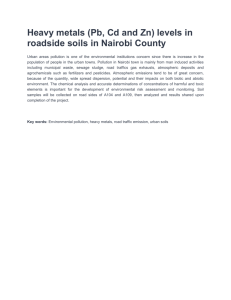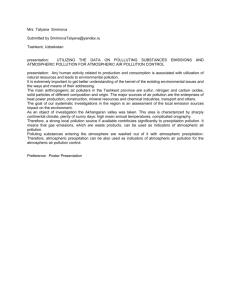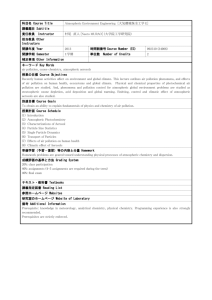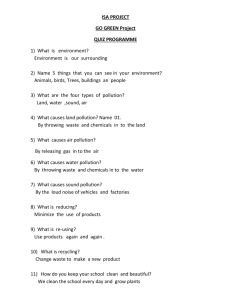Monitoring Progress - World Health Organization
advertisement
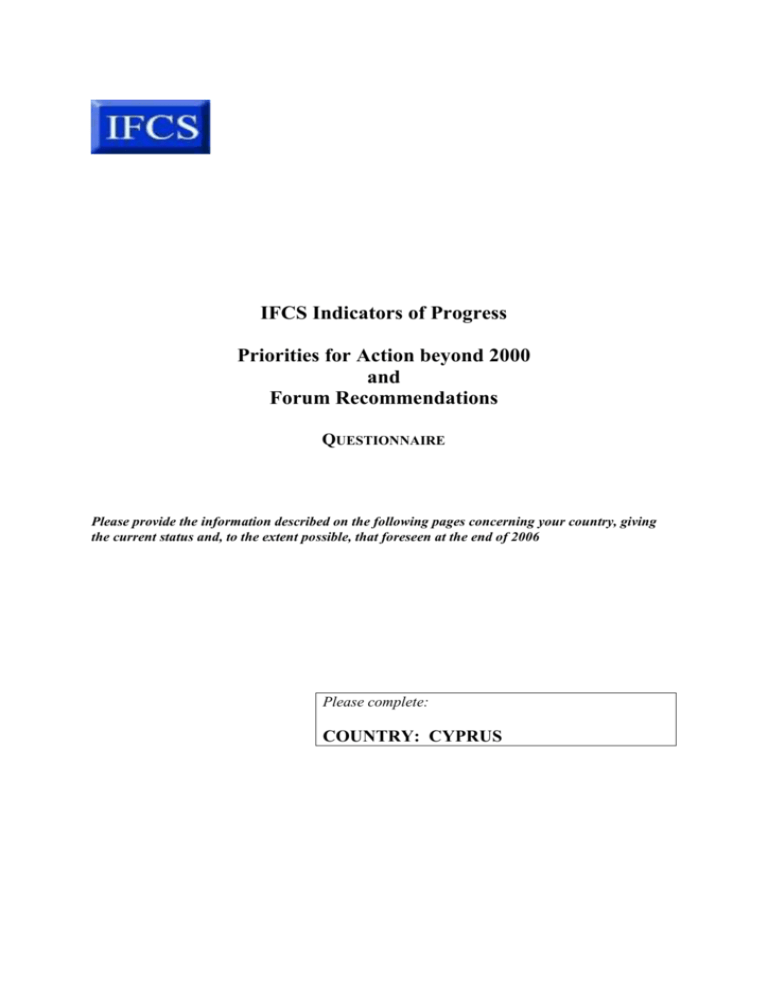
IFCS Indicators of Progress Priorities for Action beyond 2000 and Forum Recommendations QUESTIONNAIRE Please provide the information described on the following pages concerning your country, giving the current status and, to the extent possible, that foreseen at the end of 2006 Please complete: COUNTRY: CYPRUS 1. NATIONAL CAPABILITIES AND CAPACITIES FOR CHEMICALS MANAGEMENT Priorities for Action E1 and E21 1a) Has a comprehensive National Chemicals Management Profile, or other equivalent strategic national plan, been developed through a multi-stakeholder process2? National Profile Yes Other equivalent strategic national plan No Yes No If "Yes" to either of the above, please indicate the original publication date and the date(s) of any revisions. ___________________________________________________________ If "Yes" to either of the above, please list all ministries, agencies and organizations that participated: ____________________________________________________________ ____________________________________________________________ If "No", is your country in the process of developing or planning on developing a Comprehensive National Chemicals Management Profile? Yes Expected completion date _end of 2005_ No If "No", have equivalent measures such as a government investigation on chemical safety followed by legislative measures been undertaken? Yes No If "Yes", please describe: The Department of Labour Inspection has a well established labour inspection system for controlling various factors affecting health and safety of workers and third persons at work. Chemical agents are among those factors and special regulations to control them have been issued under the Safety and Health at Work Laws of 1996 to 2003. Also new legislation on the management and control of chemical substances has been issued during the process of harmonising the Cyprus legislation with the respective European Acquis. All Cyprus legislation related to chemicals' management and control, for which the Department of Labour Inspection has the competency is shown in Annex I. 1 The Priorities for Action Beyond 2000 may be viewed on the IFCS website at www.ifcs.ch. A multi-stakeholder process is a process involving all concerned national ministries and other government institutions, as well as other interested national parties. 2 1 1b) Has your country developed any of the following on the sound management of chemicals? If yes, please provide year completed. If development is in progress, please provide the expected completion year? National Policies 2005 National Priorities 2004 National Strategies 2004 National Action Plans 1c) No 2004 Has your country established an inter-ministerial/intersectoral coordinating mechanism (e.g. committee or body) to facilitate the comprehensive treatment of chemical safety issues? Yes No If "Yes": What is the name of the "mechanism"? When was it established? 1. “Labour Advisory Board” a tripartite Body for the coordination of Labour issues established in 1952. 2. Various Interministerial Technical Committees that examine environmental issues and issues related to chemicals' management and control such as: a. The Poison Control Board established by the Ministry of Agriculture, Natural Resources and Environment that examines issues related to pesticides control. b. A Technical Committee established under the Dangerous Substances Laws of 1991 to 2004 to examine various issues related to the placing on the market, control and risk assessment of dangerous substances. 2. CLASSIFICATION AND LABELLING OF CHEMICALS Priority for Action B1 2a) Has your country initiated work to adopt and implement the Globally Harmonized System for Classification and Labelling of Chemicals (GHS)? Yes No If "Yes", what is the expected date (year) GHS will be fully operational? Cyprus together with the rest of EU Member States is planning to implement GHS. This is foreseen to take place after 2007. -2D:\106745631.doc 2b) Has your country ratified and implemented ILO Convention 170 on Safety in the Use of Chemicals at Work3, or instituted comparable measures? Yes 3. No NATIONAL ARRANGEMENTS FOR EXCHANGE OF INFORMATION ON HAZARDOUS CHEMICALS Priority for Action C1 3a) What arrangements are operational in your country for the exchange of information on hazardous chemicals? Please describe. Information is available at the Department of Labour Inspection and through its website. Please indicate if the established infrastructure includes: 1) website where national partners can gain access to chemical information sources, Yes No 2) institutional directory listing sources of information Yes 4. No NATIONAL PROCEDURES ON SAFETY INFORMATION FOR HAZARDOUS MATERIALS IN CIRCULATION Priority for Action C3 4a) Does your country have procedures in place to ensure that any hazardous material put into circulation is accompanied, at a minimum, by appropriate and reliable safety information that is easy to access, read and understand? Yes No If "Yes": Are the procedures consistent with the safety data sheets of the 1990 International Labour Organization Chemicals Convention (No.170)? Yes No Do they conform to the Globally Harmonized System for the Classification and Labelling of Chemicals? Yes 3 No ILO Convention 170 may be viewed on the ILO website at: http://www.ilo.org/ilolex/english/convdisp1.htm -3- D:\106745631.doc 5. ECOLOGICALLY SOUND AND INTEGRATED STRATEGIES FOR PEST MANAGEMENT Priority for Action D1 5a) Has your country prepared integrated pest management strategies? Yes No If "Yes", were national studies done to develop the strategies? Yes 6. No OBSOLETE STOCKS OF PESTICIDES AND OTHER CHEMICALS Priority for Action D2 6a) Are there any obsolete stocks of pesticides and/or other chemicals in your country? Yes 6b) No Has your country prepared an action plan for disposal of obsolete stocks of pesticides and other chemicals? Yes No If "Yes", has the action plan been implemented? Yes No If "Yes", has the action plan been completed? Yes No If "No", is work in progress to prepare an action plan? Yes If yes, what is the expected completion date (year)? ___________ No If no, why not? _________________________________________ 7. NATIONAL SYSTEMS FOR PREVENTION OF MAJOR INDUSTRIAL ACCIDENTS AND EMERGENCY PREPAREDNESS & RESPONSE Priority for Action D4 7a) Has your country implemented a national system for emergency preparedness and response, in accordance with international principles 4? Yes No If "No", is work in progress to implement the system? Yes expected completion date (year)? ___2006_____ No ڤ 7b) Is there a national law requiring the system? 4 Ref. OECD Second Edition 2003 Guiding Principles for Chemical Accident Prevention, Preparedness and Response, undertaken in cooperation with other international organizations, including ILO, IMO, UNECE, UNEP, UNOCHA (UNEP/OCHA Joint Environment Unit) and WHO. -4D:\106745631.doc Yes 7c) No Has your country ratified and implemented ILO Convention 174 5 on Prevention of Major Industrial Accidents? Yes No If "No", are efforts under way to do so? Yes 8. No INTERNATIONAL CODE OF CONDUCT ON THE DISTRIBUTION AND USE OF PESTICIDES 8a) Has your government implemented the revised International Code of Conduct on the Distribution and Use of Pesticides (November 2002)6 as the basis for a comprehensive life cycle approach to pesticide management? Yes No If "No", are efforts under way to do so? Yes 8b) No Have the provisions of the Code of Conduct been implemented through other pieces of legislation or by other means? Yes No If "Yes", please briefly describe. Through the ratification of the Rotterdam Convention on the Prior Informed Consent for Certain Hazardous Chemicals and Pesticides in Internationals Trade (Ratifying Law of 2004). 9. POISON CENTRES Priority for Action D7 9a) Have poison centre(s) been established in your country? Yes No If "Yes", please indicate classification level for each poison centre: WHO Status of Development Classification well-established centres, the full range of clinical analytical and other relevant facilities and A 5 ILO Convention 170 may be viewed on the ILO website at: http://www.ilo.org/ilolex/english/convdisp1.htm 6 The International Code of Conduct on the Distribution and Use of Pesticides may be viewed at: http://www.fao.org/AG/AGP/AGPP/Pesticid/ -5D:\106745631.doc B C cover the whole country. well-established centres, but lack some of the related facilities or do not provide full coverage to the country. These centres require further development in order to meet the ideal criteria for centres given in the IPCS Guidelines certain facilities for poison control, but require major support to develop further areas of activities, according to the criteria in the IPCS Guidelines, and should expand coverage through the country. Centre (Name & location) The Drug Information and Poison Control Centre, located at the Pharmaceutical Services of the Ministry of Health 9b) Date Established Classification initial Classification 2000 Classification current 1996 C C C Is strengthening of poison centers planned? Yes If "Yes", for what time period? According to a recent decision of the Council of Ministers a new Poison Center located at the Nicosia General Hospital will be established within 2005 9c) If there are no established poison centres in your country, is work under way in your country to establish a poison control centre with related chemical and analytical facilities for the first time? Yes No If "Yes" when do you expect the poison control centre to be operational? Please provide location and date (year). ________________________________________________________ 10. POLLUTANT RELEASE AND TRANSFER REGISTERS/EMISSION INVENTORIES Priority for Action D8 10a) Has your country established: An air emission inventory? Yes No -6- D:\106745631.doc A land emission inventory? Yes No A water emission inventory? Yes No A waste inventory? Yes No A Pollutant Release and Transfer Register (PRTR)? Yes No If "No", is work being initiated to design a PRTR or emission inventory system? Yes 10 b) Has your country implemented a system comparable to the PRTR (e.g. the Integrated Pollution Prevention and Control)? Yes 11. No No PREVENTION OF ILLEGAL TRAFFIC IN TOXIC & DANGEROUS PRODUCTS Priority for Action F 11a) Has your country developed a national strategy, or other national measures (e.g. legislation, action plans) for the prevention of illegal traffic in toxic and dangerous products? Yes No If "Yes", when was it prepared? Please indicate date (year) 30.4.2004 On that date Ratifying Laws for the Rotterdam Convention on the Prior Informed Consent for Certain Hazardous Chemicals and Pesticides in International Trade and the Stockholm Convention on POPs have been issued. These are some of the national measures for preventing illegal trafic of toxic and dangerous products. 12. Children and Chemical Safety (Forum IV Recommendation) 12a) Has your government prepared, through multi-stakeholder consultation, initial national assessments of children’s environmental health and chemical safety? -7D:\106745631.doc Yes No If "No", are efforts under way to do so? Yes 12b) No Has your government taken action to promote harmonized data collection, research, legislation and regulations, and the use of indicators of children’s environmental health? Yes No If "Yes", please briefly describe: If "No", are efforts under way to do so? Yes 13. No HAZARD DATA GENERATION (Forum IV Recommendation) 13a) Has your government established national priorities for information generation for chemicals that are not produced in high volumes? Yes No If "No", are efforts under way to do so? Yes No Other Forum IV Recommendations address: Please provide brief information on specific actions your government has taken to respond to the recommendations of Forum IV in these areas: Occupational Safety and Health; Acutely Toxic Pesticides – risk management and reduction; Capacity building; INFOCAP (Information Exchange Network on Capacity Building for the Sound Management of Chemicals ) implementation. The Cyprus Government has taken the following actions to respond to the recommendations of Forum IV. (a) Occupational Safety and Health; Workplace data are being recorded, collected and analysed at the DLI through a well developed system of data collection and introduction of these data to the central computerised system of the DLI. These data are collected through an system that has been created and structured according to the provisions of the ILO Occupational Safety and Health Convention (155) of 1981. The Cyprus Safety and Health legislation is fully harmonised to the respective EU legislation. -8D:\106745631.doc (b) Acutely Toxic Pesticides – risk management and reduction; Control of acutely toxic pesticides is achieved through the ratification in 2004 of the Rotterdam Convention on Prior Informed Consent for certain toxic substances and pesticides in international trade. European Regulation 304/2003 establishes a control system for such toxic substances within the Community. In addition to the above piece of legislation, new legislation on Pesticides and Biocides Control, fully harmonised with the European Acquis, has entered into force before Cyprus joined the European Union in 2004. The Pesticides Control Board, a Body established by the Pesticides Law, is taking decisions on the management, distribution and control of pesticides in Cyprus. All decisions leading to restrictions and prohibitions for import and use of certain acutely toxic pesticides are taken by the above Board. (c) Capacity building; The DLI, in cooperation with the Social Partners, is promoting actions for improving the currently existing level of awareness in Safety and Health issues at the enterprise level for both employers and employees. These actions include distribution of awareness material, organisation of seminars and promotion of risk assessment techniques of all involved. A recent jointed project (Work Life Enlargement) of the DLI with the Swedish Work Environment Authority had as a result the exchange of experiences and ideas for the promotion of safety and health at work. In 2004 the Cyprus National Committee on "Environment and Children Health" has been established by a Ministerial Decision. This Committee is multidisciplinary with members from the governmental and private sector, specialists in the fields of children's health, chemicals, environment and education. (d) INFOCAP (Information Exchange Network on Capacity Building for the Sound Management of Chemicals ) implementation The DLI, being the IFCS Focal Point for Cyprus, plans to actively participate in the exchange of information promoted by INFOCAP. As a first step of this active involvement, the DLI is planning the preparation of the Cyprus Chemical Profile, expected to be completed within 2005. -9D:\106745631.doc Details of person completing the questionnaire: IFCS National Focal Point: Yes No Name: Leandros Nicolaides Title: Director Ministry Ministry of Labour and Social Insurance Department of Labour Inspection, Address 12, Apelli Street Nicosia, 1493 CYPRUS Tel: + 357 22 405623 Fax: + 357 22 663788 Date: Email: director@dli.mlsi.gov.cy Signature: 9.02.2005 Please provide the following additional information: Does the IFCS National Focal Point have direct access to the Internet in his/her office? Yes No If "No", does he/she have access to the Internet in the building where he/she works? Yes No - 10 D:\106745631.doc Annex I Selected Legislation on Chemicals Management and Control for which the Department of Labour Inspection has the Competency Document Title Code Number HEALTH AND SAFETY ISSUES AT WORK The Safety and Health at Work Law of 1996 Law 89(I)/1996 The Safety and Health at Work (Amendment) Law of 2001 Law 158(I)/2001 The Safety and Health at Work (Amendment) Law of 2002 Law 25(I)/2002 The Safety and Health at Work (Amendment) Law of 2003 Law 41(I)/2003 The Safety and Health at Work (Biological Agents) Regulations of 2001 The Safety and Health at Work (Carcinogenic and Mutagenic Agents) Regulations of 2001 The Safety and Health at Work (Carcinogenic and Mutagenic Agents) Regulations (Amendment) of 2004 The Safety and Health at Work (Chemical Agents) Regulations of 2001 The Safety and Health at Work (Chemical Agents) (Amendment) Regulations of 2004 The Control of Major Accidents Hazards Related to Dangerous Substances Regulations of 2001 The Control of Major Accidents Hazards Related to Dangerous Substances Notification of 2002 The Control of Factory Atmosphere and Dangerous Substances in Factories Regulations of 1973 The Control of Factory Atmosphere and Dangerous Substances in Factories (Amendment) Regulations of 1981 The Control of Factory Atmosphere and Dangerous Substances in Factories (Amendment) Regulations of 1986 The Asbestos (Safety and Health of Persons at Work) Law of 1993 The Asbestos (Safety and Health of Persons at Work) (Amendment) Law of 2000 The Asbestos (Safety and Health of Persons at Work) Regulations of 1993 The Asbestos (Safety and Health of Persons at Work) Law of 1993 The Asbestos (Safety and Health of Persons at Work) Regulations of 1993 (Notification of 1994) The Asbestos (Safety and Health of Persons at Work) Regulations of 1993 (Notification of 1993) The Asbestos (Safety and Health of Persons at Work) (Amendment) Regulations of 2000 The Asbestos (Safety and Health of Persons at Work) (Amendment) (Amendment) Regulations of 2004 The Asbestos (Safety and Health of Persons at Work) Regulations of 2000 (Notification of 2002) AIR POLLUTION CONTROL The Control of Atmospheric Pollution Law of 2002 The Control of Atmospheric Pollution (Limitation and Control of Atmospheric Pollution caused by Waste from Titanium Dioxide Industry) Regulations of 2002 The Control of Atmospheric Pollution (Limitation and Control of Atmospheric Pollution caused by Waste from Titanium Dioxide Industry) Notification of 2004 The Control of Atmospheric Pollution (Prevention and Reduction of Atmospheric Pollution by Asbestos) Regulations of 2002 The Control of Atmospheric Pollution (Prevention and Reduction of Atmospheric Pollution by Asbestos) Notification of 2004 Date of issue 1.11.1996 31.12.2001 29.3.2002 23.5.2003 P.I. 144/2001 P.I. 153/2001 6.4.2001 6.4.2001 P.I. 493/2004 30.4.2004 P.I. 268/2001 P.I. 55/2004 P.I. 507/2001 6.7.2001 6.2.2004 31.12.2001 P.I. 211/2002 26.4.2002 P.I. 311/73 P.I. 166/81 24.7.1981 P.I. 41/86 21.2.1986 Law 23(I)/93 Law 47(I)/2000 P.I. 272/93 P.I.108/94 14.5.1993 14.4.2000 19.11.1993 28.4.94 P.I. 170/93 25.6.93 P.I. 104/2000 21.4.2000 P.I. 495/2004 30.4.2004 P.I. 447/2002 27.9.2002 Law 187(I)/2002 P.I. 527/2002 1.11.2002 1.11.2002 P.I. 187/2004 26.3.2004 P.I. 528/2002 1.11.2002 P.I. 186/2004 26.3.2004 - 11 D:\106745631.doc Document Title The Control of Atmospheric Pollution (Incineration of Waste Oils) Regulations of 2002 The Control of Atmospheric Pollution (Procedures for the Surveillance and Monitoring of Environments concerned by Waste from Titanium Dioxide Industry) Regulations of 2002 The Control of Atmospheric Pollution (Procedures for the Surveillance and Monitoring of Environments concerned by Waste from Titanium Dioxide Industry) Notification of 2004 The Control of Atmospheric Pollution (Incineration of Hazardous Wastes) Regulations of 2002 The Control of Atmospheric Pollution (Incineration of Hazardous Wastes) Notification of 2004 The Control of Atmospheric Pollution (Limitation of Volatile Organic Compounds due to the Use of Organic Solvents in Certain Activities and Installations) Regulations of 2003 The Control of Atmospheric Pollution (Limitation of Volatile Organic Compounds due to the Use of Organic Solvents in Certain Activities and Installations) Notification of 2004 The Control of Atmospheric Pollution (Limitation of Emissions of Certain Pollutants into the Air from Large Combustion Plants) Regulations of 2003 The Control of Atmospheric Pollution (Limitation of Emissions of Certain Pollutants into the Air from Large Combustion Plants) Notification of 2004 The Control of Atmospheric Pollution (Prevention of Air Pollution from Existing Municipal Incineration Plants) Regulations of 2003 The Control of Atmospheric Pollution (Prevention of Air Pollution from Existing Municipal Incineration Plants) Notification of 2004 The Control of Atmospheric Pollution (Control of Volatile Organic Compounds Emissions Resulting from the Storage of Petrol and its Distribution from Terminals to Service Stations) Regulations of 2003 The Control of Atmospheric Pollution (Control of Volatile Organic Compounds Emissions Resulting from the Storage of Petrol and its Distribution from Terminals to Service Stations) Notification of 2004 The Control of Atmospheric Pollution (Incineration of Waste) Regulations of 2003 The Control of Atmospheric Pollution (Incineration of Waste) Notification of 2004 The Air Pollution Control Order of 2003 The Control of Atmospheric Pollution (Non Licensable Installations) Regulations of 2004 The Control of Atmospheric Pollution (Limitation of Emissions of Certain Pollutants into Air from Large Combustion Plants) Regulations of 2004 The Integrated Pollution Prevention and Control Law of 2003 The Integrated Pollution Prevention and Control Notification of 2004 The Protocol to the 1979 Convention on Long-range Transboundary Air Pollution on Heavy Metals (Ratifying) Law of 2004 The Protocol to the 1979 Convention on Long-range Transboundary Air Pollution on Persistent Organic Pollutants (Ratifying) Law of 2004 The Protocol to the 1979 Convention on Long-range Transboundary Air Pollution concerning the Control of Emissions of Nitrogen Oxides or their Transboundary Fluxes (Ratifying) Law of 2004 The Air Quality Law of 2002 The Air Quality Notification of 2004 The Air Quality (Amendment) Law of 2004 The Air Quality (Amendment) (No. 2) Law of 2004 The Air Quality (Limit Values for Benzene and Carbon Monoxide in Ambient Air) Regulations of 2002 The Air Quality (Limit Values for Benzene and Carbon Monoxide in Ambient Air) Notification of 2004 Code Number P.I. 529/2002 1.11.2002 P.I. 545/2002 15.11.2002 P.I. 188/2004 26.3.2004 P.I. 638/2002 27.12.2002 P.I. 185/2004 26.3.2004 P.I. 73/2003 31.1.2003 P.I. 189/2004 26.3.2004 P.I. 74/2003 31.1.2003 P.I. 184/2004 26.3.2004 P.I. 75/2003 31.1.2003 P.I. 183/2004 26.3.2004 P.I. 76/2003 31.1.2003 P.I. 181/2004 26.3.2004 P.I. 284/2003 P.I. 182/2004 P.I. 658/2003 P.I. 170/2004 11.4.2003 26.3.2004 8.8.2003 26.3.2004 P.I. 195/2004 2.4.2004 Law 56(I)/2003 P.I. 268/2004 Law 38(III)/2004 13.6.2003 23.4.2004 30.4.2004 Law 39(III)/2004 30.4.2004 Law 40(III)/2004 30.4.2004 Law 188(I)/2002 P.I. 330/2004 Law 53(I)/2004 Law 54(I)/2004 P.I. 516/2002 1.11.2002 30.4.2004 31.3.2004 31.3.2004 1.11.2002 P.I. 337/2004 30.4.2004 Date of issue - 12 D:\106745631.doc Document Title The Air Quality (Air Pollution by Ozone) Regulations of 2002 The Air Quality (Limit Values for Sulphur Dioxide, Nitrogen Dioxide and Nitrogen Oxides, Particulate Matter and Lead in Ambient Air) Regulations of 2002 The Air Quality (Limit Values for Sulphur Dioxide, Nitrogen Dioxide and Nitrogen Oxides, Particulate Matter and Lead in Ambient Air) Notification of 2004 The Air Quality (Annual Emission Ceilings for Certain Atmospheric Pollutants) Regulations of 2004 The Air Quality (Ozone in Ambient Air) Regulations of 2004 Code Number P.I. 530/2002 P.I. 574/2002 1.11.2002 29.11.2002 P.I. 338/2004 30.4.2004 P.I. 193/2004 2.4.2004 P.I. 194/2004 2.4.2004 Law 199/91 Law 27(Ι)/97 Law 81(I)/2002 Law 194(I)/2004 P.I. 292/2002 8.11.1991 18.4.1997 21.6.2002 30.4.2004 21.6.2002 P.I. 536/2004 30.4.2004 P.I. 339/2004 30.4.2004 P.I. 686/2004 13.8.2004 Law 20(ΙΙΙ)/2004 30.4.2004 Ν. 42(ΙΙΙ)/2004 30.4.2004 Date of issue DANGEROUS SUBSTANCES The Dangerous Substances Law of 1991 The Dangerous Substances (Amendment) Law of 1997 The Dangerous Substances (Amendment) Law of 2002 The Dangerous Substances (Amendment) Law of 2004 The Dangerous Substances (Classification, Packaging and Labelling of Dangerous Substances and Preparations) Regulations of 2002 The Dangerous Substances (Classification, Packaging and Labelling of Dangerous Substances and Preparations) (Amendment) Regulations of 2004 The Dangerous Substances (Classification, Packaging and Labelling of Dangerous Substances and Preparations) Notification of 2004 The Dangerous Substances (Classification, Packaging and Labelling of Dangerous Substances and Preparations) Notification of 2004 The Rotterdam Convention on the Prior Informed Consent for Certain Hazardous Chemicals and Pesticides in International Trade Ratifying Law of 2004 The Stockholm Convention on Persistent Organic Pollutants Ratifying Law of 2004 - 13 D:\106745631.doc
